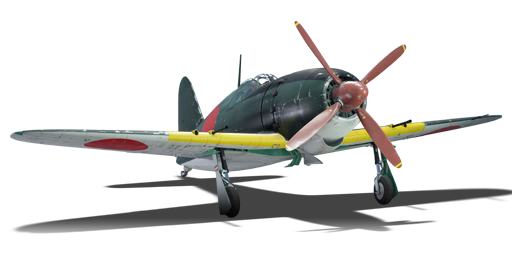



The J2M3 Model 21, designated as Raiden Mod.21 (雷電二一型), was an uparmed variant of the previous J2M2 by replacing the nose-mounted machine guns with two Type 99 Model 1 20 mm cannons in the wings. It also used belt feeds instead of drum magazines for both Model 1 and Model 2 cannons resulting in greater ammunition capacity. The J2M3 was the most widely produced variant of the Raiden series.
It was introduced in Update 1.45 "Steel Generals". Unlike its previous model, this Raiden wields four 20 mm cannons, specifically two Model 1s and two Model 2s with more ammo, which means an even more deadly strafe that reduces the need to make a second pass. While maintaining the same engine, it results in the same great climber, but at a higher battle rating facing potentially more dangerous targets which may be able to keep up with the Raiden.
flaps
flaps
flaps
brake
| Belt | Belt filling | Armor penetration (mm) at a distance: | |||||
|---|---|---|---|---|---|---|---|
| 10 m | 100 m | 500 m | 1000 m | 1500 m | 2000 m | ||
| T/FI/FI/APHE | 26 | 24 | 17 | 10 | 6 | 4 | |
| HEF-T/HEF/HEF/APHE | 26 | 24 | 17 | 10 | 6 | 4 | |
| APHE/APHE/APHE/APHE/HEF/HEF-T | 26 | 24 | 17 | 10 | 6 | 4 | |
| HEF-T | 4 | 4 | 4 | 4 | 4 | 4 | |
| HEF/HEF/HEF/APHE/APHE | 26 | 24 | 17 | 10 | 6 | 4 | |
| Belt | Belt filling | Armor penetration (mm) at a distance: | |||||
|---|---|---|---|---|---|---|---|
| 10 m | 100 m | 500 m | 1000 m | 1500 m | 2000 m | ||
| T/HEF-I/HEF-I/APHE | 19 | 18 | 12 | 7 | 5 | 4 | |
| HEF-T/HEF/HEF/APHE | 21 | 20 | 13 | 8 | 5 | 4 | |
| APHE/APHE/APHE/APHE/HEF/HEF-T | 21 | 20 | 13 | 8 | 5 | 4 | |
| HEF-T | 4 | 4 | 4 | 4 | 4 | 4 | |
| HEF/HEF/HEF/APHE/APHE | 21 | 20 | 13 | 8 | 5 | 4 | |












Flight performance | |
|---|---|
Survivability |
|---|
Weaponry | ||
|---|---|---|